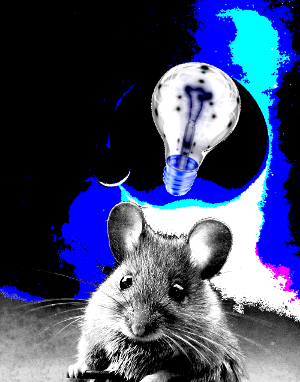Light shines on memory circuits in mind-bending advance
 In a medical advance straight from science fiction - researchers have used light to create, erase and retrieve memories within the brain of a live mouse.
In a medical advance straight from science fiction - researchers have used light to create, erase and retrieve memories within the brain of a live mouse.
The US study has shown and manipulated the specific neurological process for creating memories.
It provides the first cause-and-effect evidence that strengthened connections between neurons are how memories physically form.
Researchers used the incredible new techniques of optogenetic stimulation to create and manipulate a memory in the mind of a mouse.
Optogenetics involves the implanting of devices to allow the neural circuitry of the brain to be stimulated externally, using pulses of light.
“Our results add to mounting evidence that the brain represents a memory by forming assemblies of neurons with strengthened connections, or synapses,” said researcher Dr Roberto Malinow, from the University of California, San Diego (UCSD).
“Further, the findings suggest that weakening synapses likely disassembles neuronal assemblies to inactivate a memory.”
Neuroscientists have long suspected that strengthened connections between neurons – called long-term potentiation (LTP) – underlies memory formation.
This hypothesis has been played out in real life, with the team detecting LTP when forming a memory, removing the memory (with a process known to reverse LTP), and then bringing the memory back via LTP – all by modifying the strength of synapses in a memory circuit.
To create the memory, researchers linked a small electric shock to the foot of a mouse with the optogenetic circuitry in its brain.
A specific group of neurons dedicated to auditory fear was stimulated every time the mouse was shocked.
By varying the pattern of optogenetic stimulation, the researchers were able to strengthen connections between neurons in the circuit by promoting LTP or weaken the connections by promoting a countervailing process called long-term depression (LTD).
This made it possible to readily form a fear memory, remove it, and then bring it back.
The study aims to develop ways to repair and retrieve parts of the brain damaged by trauma, disease, age or other influences.
“We have shown that the damaging products that build up in the brains of Alzheimer's disease patients can weaken synapses in the same way that we weakened synapses to remove a memory,” said Dr Malinow.
“So this line of research could suggest ways to intervene in the process.”
“In addition to eliminating any doubt about a link between LTP/LTD with memories, this work highlights the staggering potential of precision targeting and circuit manipulation for alleviating maladaptive memories,” said project officer Chiiko Asanuma, PhD.








 Print
Print